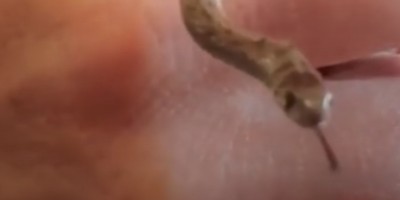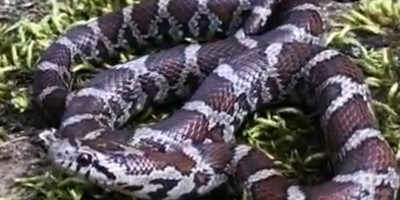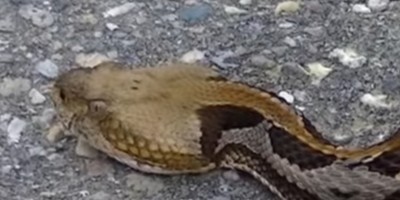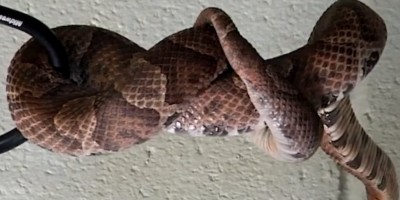
Welcome to bostonsnakes.com! I am David, a snake enthusiast living in Boston, MA. Many people don't know that Boston is in fact full of snakes! You just need to know where to find them - they can often be shy and elusive. Some Massachusetts snake species are more common outside of the city limits, in different parts of Suffolk County MA, but many types of snakes are indeed common in the more urban parts of Boston. This guide is meant to help educate you about the beautiful snakes of Boston, and to help you identify the most common snakes of Boston, as well as the venomous snakes of Boston that you should learn to recognize and avoid. If you want more detail, click here for my complete list of ALL snake species in Boston. Remember the following:
- Most snakes of Boston are harmless and don't want to encounter you
- Venomous snakes exist but are uncommon in Boston, Massachusetts
- Snakes eat rats and mice and are a valuable part of the Massachusetts ecosystem
- Never kill a snake - if you leave a snake alone, it will leave you alone.
Common Snake Species in Boston
 Dekay’s brownsnake:
Dekay’s brownsnake is a small, thin snake, usually brown or grey. They grow to about 9 to 13 inches in length. Adults have two rows of parallel dark spots that border a white stripe running down the back of the snake. There is also a dark stripe on either side of its neck, although younger Dekay’s brown snakes may have lighter colored markings on their necks. Dekay’s brown snakes are found in most terrestrial habitats and wetlands. They are very secretive and often found under rocks, logs, or shaded covers. They can also be found in suburban areas. Their diet consists of small frogs, fish, snails, tadpoles, and so on. They are nocturnal only coming out at night or late evening and resting at night. Dekay’s brown snakes are non-venomous and non-aggressive. They typically do not bite when threatened but they can squirm and flatten their bodies, releasing a repugnant musk located in the base of their tails.
Dekay’s brownsnake:
Dekay’s brownsnake is a small, thin snake, usually brown or grey. They grow to about 9 to 13 inches in length. Adults have two rows of parallel dark spots that border a white stripe running down the back of the snake. There is also a dark stripe on either side of its neck, although younger Dekay’s brown snakes may have lighter colored markings on their necks. Dekay’s brown snakes are found in most terrestrial habitats and wetlands. They are very secretive and often found under rocks, logs, or shaded covers. They can also be found in suburban areas. Their diet consists of small frogs, fish, snails, tadpoles, and so on. They are nocturnal only coming out at night or late evening and resting at night. Dekay’s brown snakes are non-venomous and non-aggressive. They typically do not bite when threatened but they can squirm and flatten their bodies, releasing a repugnant musk located in the base of their tails.  Eastern garter snake:
The eastern garter is a greyish or reddish colored snake usually reaching up to 26 inches in length. They are easily distinguishable from other snakes by the presence of 3 long stripes that run down its body but some may be checkered.The eastern garter snake is very common in most of North America, Boston included. They can be found in areas around marshes, meadows, hillsides, and woodlands. They love moist environments and prefer it to drier environments. They are also very abundant in suburban areas and they can live under shades, boards, and abandoned structures. They may be active during the day or at night depending on when food is available. They feed mainly on earthworms, insects, small frogs, and fish. The eastern garter snake is non-venomous but can be aggressive if threatened. Their bite is capable of causing an allergic reaction in humans although not fatal.
Eastern garter snake:
The eastern garter is a greyish or reddish colored snake usually reaching up to 26 inches in length. They are easily distinguishable from other snakes by the presence of 3 long stripes that run down its body but some may be checkered.The eastern garter snake is very common in most of North America, Boston included. They can be found in areas around marshes, meadows, hillsides, and woodlands. They love moist environments and prefer it to drier environments. They are also very abundant in suburban areas and they can live under shades, boards, and abandoned structures. They may be active during the day or at night depending on when food is available. They feed mainly on earthworms, insects, small frogs, and fish. The eastern garter snake is non-venomous but can be aggressive if threatened. Their bite is capable of causing an allergic reaction in humans although not fatal.
 Eastern milk snake:
Eastern milk snakes are moderately sized snakes with colors ranging from light brown to grey. Adults are typically around 2 to 5 feet. They have square-shaped blotches which may be reddish-brown in color running down their backs. On their belly, they have a white and black checkered pattern. The eastern milk snake is often mistaken for the copperhead due to the resemblance between them. Copperheads, however, have hourglass-shaped blotches, while eastern milk snakes have square blotches. Eastern milk snakes can be found mostly in open spaces. They live in forests, barns, under large rocks, or debris. They are mostly active at night but they may be seen during the day sometimes. Their diet consists of lizards, rats, and other snakes. Contrary to the belief that eastern milk snakes drink milk from the cows in the barn, they do not. They are mostly in barns to look for rats and lizards. This snake is non-venomous. When threatened, they may vibrate their tails and release a pungent smell. They may strike and bite the intruder if they don't back away after the warning.
Eastern milk snake:
Eastern milk snakes are moderately sized snakes with colors ranging from light brown to grey. Adults are typically around 2 to 5 feet. They have square-shaped blotches which may be reddish-brown in color running down their backs. On their belly, they have a white and black checkered pattern. The eastern milk snake is often mistaken for the copperhead due to the resemblance between them. Copperheads, however, have hourglass-shaped blotches, while eastern milk snakes have square blotches. Eastern milk snakes can be found mostly in open spaces. They live in forests, barns, under large rocks, or debris. They are mostly active at night but they may be seen during the day sometimes. Their diet consists of lizards, rats, and other snakes. Contrary to the belief that eastern milk snakes drink milk from the cows in the barn, they do not. They are mostly in barns to look for rats and lizards. This snake is non-venomous. When threatened, they may vibrate their tails and release a pungent smell. They may strike and bite the intruder if they don't back away after the warning.
Venomous Snake Species in Boston
 Timber rattlesnake:
The timber rattlesnake is a large snake often described as being heavily bodied. Adult timber snakes typically reach a length of about 30 to 60 inches. Its body can be tanned or have a pinkish-grey color. It has a series of black crossbands running down its body. At the center of its body is a stripe that is reddish-brown in color and runs down the center. The tail is black in color and has a distinctive rattle which the snake usually keeps raised above the ground. Timber rattlesnakes live in damp environments preferring river beds, swamps, and bottomlands. They can also be found in Flatwoods, fields, and hardwood hammocks. Occasionally, they may be found in suburban areas where there have previously been forests. Their diets consist mainly of small mammals and sometimes birds. Sometimes they may eat frogs, lizards, or other snakes. They are mostly ambush predators, lying in wait for their prey until it is time to strike. However, they can also use their strong sense of smell to pursue and attack prey. Timber rattlesnakes are generally not aggressive snakes. They coil up and lie quietly until provoked. They will rattle their tails in warning for intruders to back off. If the intrusion continues then the snake will bite. Bites from a timber rattlesnake are very dangerous to humans and other animals.
Timber rattlesnake:
The timber rattlesnake is a large snake often described as being heavily bodied. Adult timber snakes typically reach a length of about 30 to 60 inches. Its body can be tanned or have a pinkish-grey color. It has a series of black crossbands running down its body. At the center of its body is a stripe that is reddish-brown in color and runs down the center. The tail is black in color and has a distinctive rattle which the snake usually keeps raised above the ground. Timber rattlesnakes live in damp environments preferring river beds, swamps, and bottomlands. They can also be found in Flatwoods, fields, and hardwood hammocks. Occasionally, they may be found in suburban areas where there have previously been forests. Their diets consist mainly of small mammals and sometimes birds. Sometimes they may eat frogs, lizards, or other snakes. They are mostly ambush predators, lying in wait for their prey until it is time to strike. However, they can also use their strong sense of smell to pursue and attack prey. Timber rattlesnakes are generally not aggressive snakes. They coil up and lie quietly until provoked. They will rattle their tails in warning for intruders to back off. If the intrusion continues then the snake will bite. Bites from a timber rattlesnake are very dangerous to humans and other animals.
 Northern copperhead:
The other venomous snake found in Boston is the northern copperhead. This two-toned snake is very secretive and avoids contact with humans. Adults can grow up to 24 to 37 inches in length. It has brown or reddish bands on its body while the body is copper-colored. They have a bright yellow tail. Like other pit vipers, the northern copperhead has two distinctive pits on either side of its head. Northern copperheads can mostly be found on hillsides, marshes, streams, edges of meadows, or wooded areas. They mostly consume small mice and rodents but they can also consume other reptiles if available. They are ambush predators that can blend well in their environments when waiting for their prey. Northern copperheads are venomous and a bite can be fatal to humans and animals. Unlike most venomous snakes that give signs to ward off intruders, northern copperheads give no warning and just strike when disturbed.
Northern copperhead:
The other venomous snake found in Boston is the northern copperhead. This two-toned snake is very secretive and avoids contact with humans. Adults can grow up to 24 to 37 inches in length. It has brown or reddish bands on its body while the body is copper-colored. They have a bright yellow tail. Like other pit vipers, the northern copperhead has two distinctive pits on either side of its head. Northern copperheads can mostly be found on hillsides, marshes, streams, edges of meadows, or wooded areas. They mostly consume small mice and rodents but they can also consume other reptiles if available. They are ambush predators that can blend well in their environments when waiting for their prey. Northern copperheads are venomous and a bite can be fatal to humans and animals. Unlike most venomous snakes that give signs to ward off intruders, northern copperheads give no warning and just strike when disturbed.
If you're unsure, you can email me a photo of the snake at info@bostonsnakes.com and I will email you back with the snake's species. If you found a snake skin, read my Found a Skin? page, and you can email me a photo of the skin, and I'll identify the snake for you. If you need professional Boston snake removal help, click my Get Help page, or see the below website sponsor I found, who provides that service.
Remember, the term is not poisonous snakes of Boston, it's venomous snakes of Boston. Poison is generally something you eat, and venom is injected into you. That said, dangerous snakes are very rare in Boston. The few venomous snakes of Suffolk County are rarely seen. But they are commonly misidentified, so learn about all the snake species of Boston in order to correctly identify them. These snakes are usually also found in the surrounding towns of Holtsville, Huntington, Riverhead, Stony Brook , Smithtown, Islip, Brentwood, Holbrook, Patchogue, Bay Shore, East Hampton, Southampton, and the surrounding areas.
Read our article about:
List of Equipment Needed when Removing Snakes
bostonsnakes.com domain and hosting costs made possible by the generous support of this sponsor:
